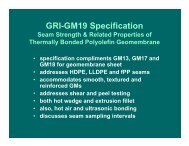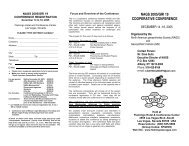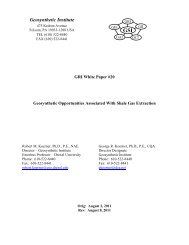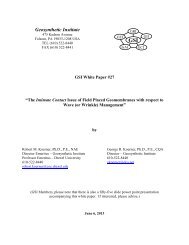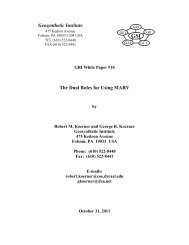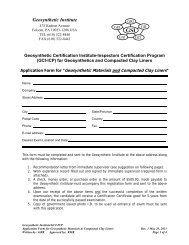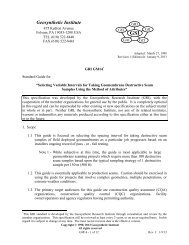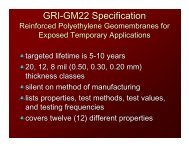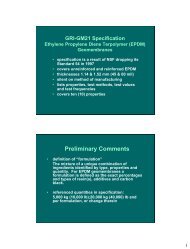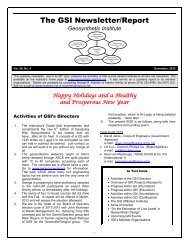GCL Design Guide - The Geosynthetic Institute
GCL Design Guide - The Geosynthetic Institute
GCL Design Guide - The Geosynthetic Institute
Create successful ePaper yourself
Turn your PDF publications into a flip-book with our unique Google optimized e-Paper software.
similar containments from entering the local environment. <strong>The</strong> concern is<br />
over leakage or failure of the storage facility which is the primary<br />
containment. <strong>The</strong> typical confining stress is in the range of 25 kN/m 2 ,<br />
whereas the hydraulic gradient is often less than 150.<br />
5.1.6 Covers for Mine Wastes, Tailings, Coal Ash, etc.—Since most residues<br />
from mining, incineration and combustion rarely have liner systems<br />
beneath them (the notable exception being heap leach mining) emphasis is<br />
to be placed on the cover. In this regard, there is similarity with landfill<br />
covers in that confining stresses are in the range of 10 to 50 kN/m 2 and the<br />
hydraulic gradient is typically less than 50. One notable exception from<br />
landfill covers is the enormous size and scale of these waste piles.<br />
Another is the regulatory setting which is generally other than an<br />
environmental agency.<br />
Note 6:<br />
6. Significance and Use<br />
<strong>GCL</strong>’s are regularly used for waterproofing of underground<br />
concrete structures but such applications are not the topic of this<br />
guide.<br />
6.1 Introduction—<strong>GCL</strong>s (by themselves or with other geosynthetics and/or soils)<br />
must be properly designed in a manner consistent with anticipated field<br />
mechanical and hydraulic forces. For example, a <strong>GCL</strong> will only function properly<br />
if hydrated and under a confining stress. This guide suggests the types of<br />
analyses and testing required to achieve an acceptable level of field performance.<br />
Where minimum design factors-of-safety are recommended, it must be recognized<br />
that the designer has the responsibility to adjust the level of performance to reflect<br />
the criticality and permeance of the site-specific application.<br />
6.2 Landfill Covers (or Caps)—Figure 1 shows a common usage of <strong>GCL</strong> within a<br />
final cover. Generally a GM/<strong>GCL</strong> composite will be the barrier, but in some<br />
cases, a multicomponent <strong>GCL</strong> may be used. In this application, the flux rate of<br />
fluid leakage through the <strong>GCL</strong> is influenced by the head of water acting on the<br />
<strong>GCL</strong> and the presence or absence of an overlying geomembrane. Typically, the<br />
head should be limited to the thickness of the overlying drainage collection<br />
system (in general, less than 300 mm for sand or gravel, and 1 cm for<br />
geosynthetic drainage systems). <strong>The</strong> flux rate of the <strong>GCL</strong> can be carried out with<br />
water as described in Test Method D 5887. <strong>The</strong> mechanical stability of the <strong>GCL</strong><br />
is mainly influenced by the slope, the confining stress and the interface friction<br />
angle with adjacent layers. Additionally, the performance of the <strong>GCL</strong> is<br />
influenced by the elongation performance of the <strong>GCL</strong> during differential<br />
settlement. Freeze/thaw effects as well as dry/wet effects in this application are<br />
dependent on the location’s climatic conditions and cover soil type and thickness.<br />
Although 1.0 m of soil cover may be sufficient, larger thicknesses may be<br />
required to prevent freezing of the bentonite clay component in the <strong>GCL</strong>. Thicker<br />
cover layers also benefit the sealing performance of the <strong>GCL</strong>; Bouazza (2002). In<br />
<strong>GCL</strong>5 - 8 of 34 Rev. 1: 1/9/13



